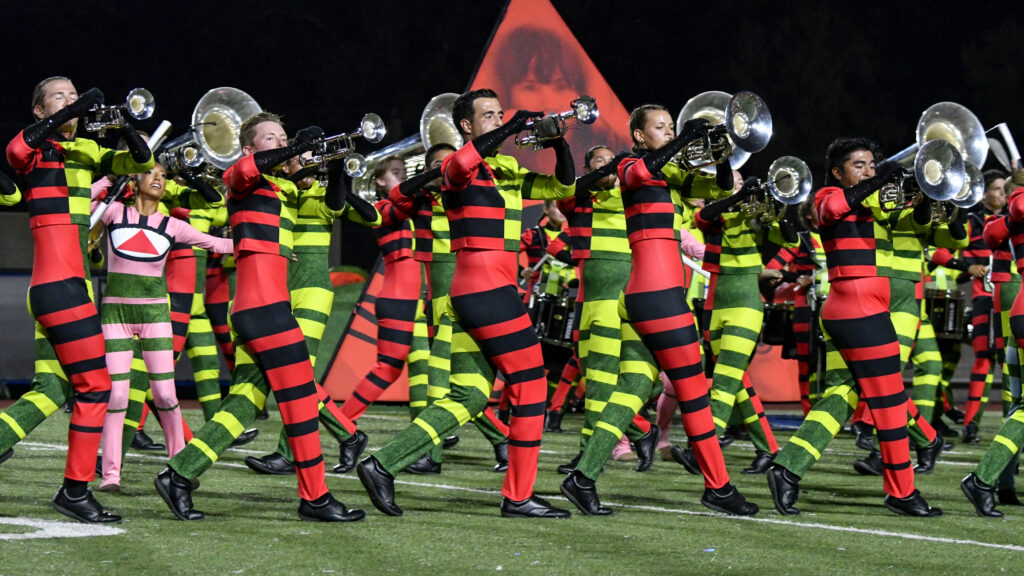Duplicating the logistics employed the season before, the Prelims competition of the 1978 Drum Corps International World Championship was held at Folsom Field on the campus of the University of Colorado in Boulder. The finalist corps then moved to Mile High Stadium in Denver, which today is the site of a parking lot for Sports Authority Field at Mile High.
At the 1978 Finals, Santa Clara Vanguard beat Phantom Regiment by a mere tenth of a point, topping a season that saw the Vanguard finish as low as fifth place during the DCI East Prelims and fourth at four other shows. Blue Devils ended the season in third, 0.35 points away from achieving a three-peat.
In 11th place, Guardsmen made the Finals for the second time, after falling out the year before. The show opened with “Rule, Britannia!” a patriotic British song written in 1740 by Thomas Arne, based on an earlier James Thomson poem of the same name. The melody is one of the most quoted musical snippets of its era, appearing in works by Beethoven, Richard Wagner, Johann Strauss, and the comic operas of Arthur Sullivan. This work prominently featured the color guard section, one of the hardest working units on the field. The guard remained in a stern and animated temperament of British pageantry, with exaggerated straight-arm and straight-leg motions that had to have taxed the members’ stamina.
The second half of the opener was “Fanfare-Rondeau” by Jean-Joseph Mouret, a Baroque French composer. From his 1729 “Symphonies and Fanfares for the King’s Supper,” the work is much better known as the theme song for BBC’s “Masterpiece Theatre,” which in the 1970s gained massive popularity in America. Premiering on PBS in 1971, the show (now known simply as “Masterpiece”), became America’s longest-running weekly drama series in prime time. The recording used on the broadcast was made in 1954 in France, and due to its use on the television series, “Fanfare-Rondeau” became the composer’s only work to survive obscurity, albeit under a different title given to more than 200 years later.
German composer Leon Jessel’s “The Parade of the Wooden Soldiers” was written in 1879 for solo piano as “The Parade of the Tin Soldiers.” Due to its popularity, Jessel created a version for orchestra in 1905, and in 1912, John Philip Sousa and his band performed a version in concerts. In 1911, a Russian vaudeville impresario changed “Tin” to “Wooden” to reference a Russian legend, and that choreographed routine became a massive hit when it appeared on Broadway in 1922.
The music became well known throughout America due to the publication of several editions of sheet music in different styles and for a multitude of instrumentations. Numerous American orchestras made recordings that furthered the song’s popularity, and each year since 1933, the Rockettes have used the song in their own rendition during their annual Radio City Christmas Spectacular.

The Guardsmen used this piece solely as a percussion feature. Inspired by that Radio City Music Hall production, corps color guard instructor and future DCI Hall of Fame member, Bill Harty, introduced the guard’s replication of toy soldiers by having the rifle bearers march through a guardhouse set, one of the earliest uses of such theatrical props on the drum corps field. Though not nearly as elaborate as the make-up “mirror” employed by the Bridgemen the year before, the use of this set helped legitimize the use of sets and props in drum corps.
Chick Corea’s “Celebration Suite” served as the corps’ standstill concert production, quite a departure from the orchestral works that filled up the rest of the show. The work came off Corea’s first studio album, “No Mystery,” which won the 1975 Grammy for Best Instrumental Jazz Performance. The Guardsmen brass section spread across 50 yards for the production, quite a wide stretch for any corps.
Following the concert production was Austrian composer Franz von Suppé’s “Poet and Peasant Overture” of 1846. Along with his “Light Cavalry Overture” of 1866, it’s one of the very few works by the Romantic-era light operetta composer to still be heard today. During this section the color guard members formed a large maypole from colorful streamers attached to a tall central pole, each holding a streamer in one hand and a rifle in the other.
The Guardsmen performed the closing ballad of “Greensleeves” for the first of three consecutive years in 1978, and it subsequently became the piece fans most associate with the corps. It started life as a late 16th Century English folk song, and was not written by King Henry VIII as is often suggested. By the 17th Century, Christmas lyrics were associated with the tune, but it wasn’t until 1865 that the best loved of all Christmas renditions came into being when William Chatterton Dix penned “What Child is This?”
The show ended with a release of several dozen balloons on the back sideline, reflecting the myriad pastel colors of the final color guard flags.
1978 Overview

Michael Boo was a member of the Cavaliers from 1975-1977. He wrote about the drum corps activity for more than 35 years while serving as a staff writer for various Drum Corps International projects. During his lifetime Boo wrote for numerous other publications including an honors-winning book on the history of figure skating. He also was an accomplished composer. Boo passed away in 2020 and was inducted into the DCI Hall of Fame posthumously in 2021.





